

How does a tent designer like Bob get started? Bob writes, "I don’t know if I have told you, but my first tent was built from Cunningham’s patterns in “Light Weight Equipment.." (Gerry Cunningham, founder of GERRY, who published at least three editions of his ground-breaking equipment-making book beginning in 1959).
Bob Howe, December 16, 2013:
"The book “The Work of Frei Otto” was published in 1972 by the Museum of Modern Art, New York, and cites Frei Otto’s first installation as the Bandstand in Kassel in 1955. To say that he “studied” tensile structures is an understatement as his in-depth analysis made him the father of modern fabric structure design. He himself would not say that the origins of tensile design were all his, but it is clear that his studies brought tensile structures from the realm of art into the realm of science. I must say that all I ever did was to try to apply his science to the art of camping tents, but in doing so I was closer to making better gear than those who thought of themselves as originators without understanding the basics of tensile structures."
Geodesic tents are all tensile structures, but not all tensile structures are geodesic. Bob's tent is geodesic because it would fit on top of a globe; it's essentially a hemisphere, or half-globe. Any force hitting it is evenly distributed throughout the structure, making it very strong from winds hitting it from any angle, and strong in terms of snow loads..... The famed Moss "Parawing" is tensile but not geodesic (it's a tarp sewn with tensile lines).
Bob Howe August 9th, 2007:
"Hi Bruce, Here
are a couple of pages I scanned out of "Dome Notes"
by Peter Hjersman published in 1975 in Berkeley. I included the
bibliography to illustrate just how many people were working with
geodesics at the time. Note that most of the dates predate xxx's
work by years. A quick look at the page regarding the "Great
Circle Dome" anticipates much of what xxx claims to be his
right down to the fact that it was made of PVC pipe and covered
with sheet plastic to make a greenhouse. Whether xxx arrived at
his ideas independently I cannot say, but all of this was happening
in a rather small community centered around Berkeley and certainly
predates his work.
The other comment I would make is that the "Great Circle
Dome" was the direct genesis of the first geodesic tent I
made for Snow Lion. I developed other unique geometries on my
own later, but my first one was inspired from this book.
I also included a photo I grabbed from the internet of the The
North Face Mountain 25, one of the most durable of my designs."
Bob Howe
Designer
Lafayette, CA 94549 (more recently living in Bend, Oregon)
Please Note: All Material
below, and in all my "History of Gear" webpages, is
copyrighted, and no usage of my material is permitted unless explicit
permission is granted by me, Bruce B. Johnson, owner of OregonPhotos.com.
Much of the material below is derived from interviews and/or correspondence
with both Bob Howe and North Face head designer Mark Erickson,
as well as my own research; eg. I have read the Frei Otto book,
at least as much as I could understand, it's pretty technical.....
Editors: Please contact me at brucej@oregonphotos.com if you have interest in publishing....Others: if you were involved with one of the old-line,
vintage gear companies and have a story to tell in these pages,
please contact
me soon.
In the Bay Area of California
in the early 1970s Buckminster
Fuller's geodesic domes became all the rage. Many folks
had caught the geodesic bug and were experimenting and building
both temporary and permanent structures. A key resource for the
movement was published in Berkeley in 1975, named "Dome Notes."
Tent designer Bob Howe says that he was heavily influenced
by this book, and others published a bit earlier in the "Dome"
movement. In fact, he told me that his first back-packable geodesic
tent was directly derived from the geometries of the "Great
Circle Dome" that he found described in such written resources...
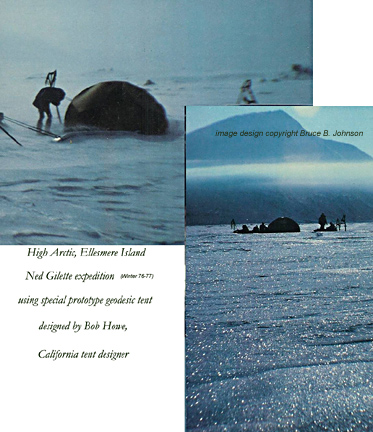 He built his backpackable
geodesic tent in 1975 (see image at top of this page). This was
the same year that North Face introduced the "Oval Intention,"
which they proudly claim to be the world's first backpacking geodesic
tent. However, 32 year old Ned Gillette, famous expeditioneer
who had been sponsored with North Face products on previous trips,
did not choose the
Oval Intention for his Spring 1977 Arctic expedition.... Instead,
Bob's new expeditionary tent became the bombproof wonder that
Ned trusted for his winter expedition to the High Arctic's Ellesmere
Island.... At page top, please see picture of a young Bob Howe
holding up the finished tent prototype in his Berkeley backyard
in 1975, and to the left see the tent in actual use at Ellesmere
Island under severe arctic conditions. According to Bob, Ned raved
about how much stronger and better this geodesic tent was compared
to anything he had used in past expeditions....See page
bottom for an obituary about Ned Gillette.
He built his backpackable
geodesic tent in 1975 (see image at top of this page). This was
the same year that North Face introduced the "Oval Intention,"
which they proudly claim to be the world's first backpacking geodesic
tent. However, 32 year old Ned Gillette, famous expeditioneer
who had been sponsored with North Face products on previous trips,
did not choose the
Oval Intention for his Spring 1977 Arctic expedition.... Instead,
Bob's new expeditionary tent became the bombproof wonder that
Ned trusted for his winter expedition to the High Arctic's Ellesmere
Island.... At page top, please see picture of a young Bob Howe
holding up the finished tent prototype in his Berkeley backyard
in 1975, and to the left see the tent in actual use at Ellesmere
Island under severe arctic conditions. According to Bob, Ned raved
about how much stronger and better this geodesic tent was compared
to anything he had used in past expeditions....See page
bottom for an obituary about Ned Gillette.
Two Examples of Bob Howe Well-known Tents
The Meridian
Tent:
Bob's Great Circle-derived geodesic dome was so successful on
Ned Gillette's expedition that the two variations of it that Bob
was introducing to the public seemed sure to succeed. Bob had
hooked up with a major, well-regarded gear company for the introduction.
The company was Snowlion, a very well-known and well-regarded
Bay-Area manufacturer during the 1970s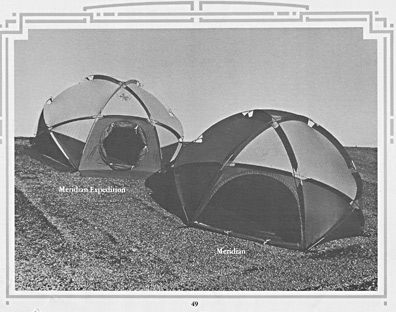 .
Interestingly, Snowlion was concurrently one of the sponsors of
Ned Gillette's arctic expedition (described above)... Below is
an image of the Meridian from page 49 of the 1977 Snowlion catalog.
.
Interestingly, Snowlion was concurrently one of the sponsors of
Ned Gillette's arctic expedition (described above)... Below is
an image of the Meridian from page 49 of the 1977 Snowlion catalog.
HOWEVER, In one of the most tragic ironies to be found in the History of Backpacking, the Snowlion catalogs got printed, but never made it into the hands of the public. In fact, I have corresponded with a fellow who participated in the photo shoot for the 1977 catalog (which was marked on its cover as a "1978" catalog*). This man related that the gear photography was shot high on Mt. Hood in Oregon....At the 1977 Outdoor Products Trade Show (Exposition) at the Houston AstroDome, where Snowlion was set to launch the new "dome" tents, an unexpected announcement was made: Snowlion was going bust and closing its doors. Snowlion's part in launching the geodesic tent revolution was erased from the history books. As for Bob Howe, he found himself launched on a lifetime career in the Outdoor Gear Industry. Interestingly, his design for the Meridian tent became popular: Bob writes, "...the tent went on. Wilderness Experience grabbed the design upon SnowLion's demise, and it also surfaced at of all places Cabelas, where it is still sold to this day." (I've also been provided with other images of the SnowLion Meridian tent, which I may post at later date)... * a note about that 1978 Snowlion catalog--- to me, the 1978 Snowlion catalog cover ranks very high as one of the most dramatic, striking, artsy covers in the History of Gear! I think it is rare and quite collectible should you find one in good condition. Should you happen across one, here is a image of the cover, taken of my personal, mint condition '78 catalog! Note the two climbers walking up the ridgeline in bottom center (one is walking into a drifting cloud and is nearly invisible). I have this catalog cover as a poster, size 33.5 x 42.5". I actually have two of them, and I'd be willing to sell one of them. Both in very good shape. brucej@Oregonphotos.com
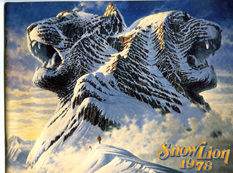 Collectible Catalog Cover, designed by
Master Illustrator/sculptor Bruce Wolfe
Collectible Catalog Cover, designed by
Master Illustrator/sculptor Bruce Wolfe
The North Face
"Mountain 25" Tent. 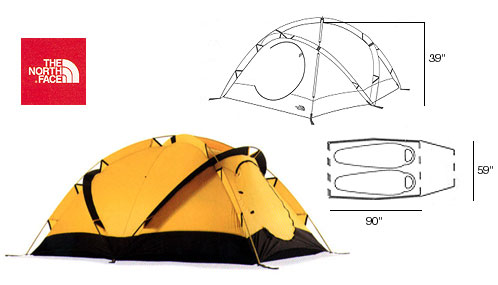 The Mountain 25 is an expedition-strong geodesic which Bob Howe
designed in 1995. He states it's been one of his most successful
and longest-lived designs, in an industry which increasingly changes
tent styles like some people do hair styles, it's a testament
to the tent's timeless qualities.
The Mountain 25 is an expedition-strong geodesic which Bob Howe
designed in 1995. He states it's been one of his most successful
and longest-lived designs, in an industry which increasingly changes
tent styles like some people do hair styles, it's a testament
to the tent's timeless qualities.
Although not originally a Bob Howe design, I add this section about the Sierra Designs "Tiros" geodesic because it is a tent that I personally own and like a lot!
The Sierra Designs "Tiros" -- The Tiros is another great tent that Bob Howe has had a hand in designing (he was not, however, the original designer, instead providing some design modifications for the tent much later, eg. 1997's version, the Tiros Guide CD model).... The Marmot Mountain Works store in Bellevue, WA had high praise for the Tiros about 12 years ago in their catalog: "The strongest 4 season tent Sierra Designs makes. This 2-person dome has a built-in vestibule and aluminum shock-corded poles. A large front door and smaller backdoor provide great ventilation. Vestibule will fit over either door." (click here to reach my page about the Tiros One tent in my ownership, with many images!).
He moved to Bend, Oregon and retired, essentially forced out of business by outsourcing of tent design to the Far East, mostly China. This echoed what happened to the process of sewing the gear during the 1980s. So Bob's 35 years in design were over. During those years, he designed tents and other products for nearly all of the major companys, and for several of the smaller ones as well. For example, early in his career, he created the "Earth Station" geodesic in 1978 for Bill Nicolai's "Early Winters"company, and in 1979 created the Great Arc Dome for Trailwise, a tent which he still says is probably the strongest backpacking tent he's ever designed, "You could do push-ups off the side of it." Backpacker Magazine loved its strength, but hated the weight and cost of its six-pole design..The American Military still use some tent designs of Bob's. One in particular is a 4 man tent with a huge vestibule fly, with all its pole of equal length (no fiddling when cold, wet, tired and darkness is setting in). Those military tents are made for the military by Eureka Tent. Co., arguably the oldest tent company in the United States.
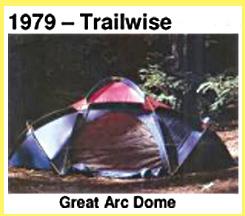
Please Note: All Material above, and in all my "History
of Gear" webpages, is copyrighted, and no usage of my material
is permitted unless explicit permission is granted by me, Bruce
B. Johnson, owner of OregonPhotos.com. Much of the material above
is derived from interviews and correspondence with both Bob Howe
and North Face head designer Mark Erickson.... Editors: Please contact
me if
you have interest in publishing (brucej@oregonphotos.com) -- Others: if you were involved
with one of the old-line, vintage gear companies and have a story
to tell in these pages, please contact me soon.
Ned Gillette met an untimely end on August 5, 1998. He was sleeping in his tent with his wife in Kashmir, an unsettled border region between India and Pakistan, when he was shot to death by what appeared to be robbers. His wife Susy Patterson was injured, but recovered. So ended a life full of adventure. For details, see the fine Obiturary written by FRANK LITSKY that appeared in the NY Times on August 14, 1998.